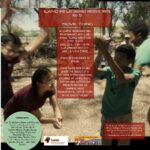by Adrian J Ivakhiv
rebloged from Immanence: thinking the form, flesh & flow of the world: ecoculture, geophilosophy, mediapolitics
Some of today’s most important eco-artists — people like Patricia Johanson, Betsy Damon, and others — work on a landscape scale with interdisciplinary groups of participants to render socio-ecological change into aesthetically tangible and artistically significant forms. Experimental dancer and choreographer Jennifer Monson’s work falls into this category as well, though, as dance, it tends to be more ephemeral and less product-oriented than even the most process-based of eco-art.
Monson, who is based at the University of Illinois but currently a visiting professor at the University of Vermont, is also artistic director of the Interdisciplinary Laboratory for Art, Nature, and Dance (iLAND). Like other performance laboratories (such as Jerzy Grotowski’s theater endeavors and their many spin-offs), iLAND works on the personal and collective process of making change through the arts, but it distinguishes itself by collaborating with the sciences more directly than do most such efforts. It does this, among other ways, by sponsoring collaborative and interdisciplinary residencies called “iLABs”, and through organizing an annual symposium at which iLAB participants present their work to the public and open it up to critical discussion of project goals, methods, and broader implications.
This year’s symposium took place last weekend. The three iLAB/iLAND projects that presented their work engaged interdisciplinary mixes of artists (including dancers, musicians, architects, and others), scientists (mostly biologists and ecologists), environmental activists and regular citizens in projects that included public performances and workshops of one kind or another. I was invited to comment on the projects on Friday and to facilitate and participate in Saturday’s workshops and discussions. A few brief observations follow. Read on…


Leave a Reply